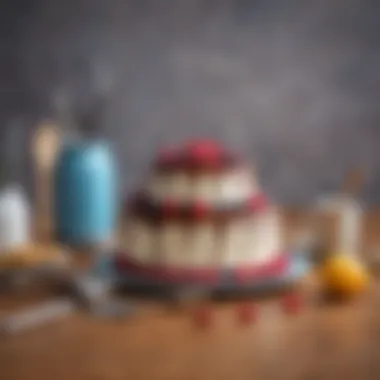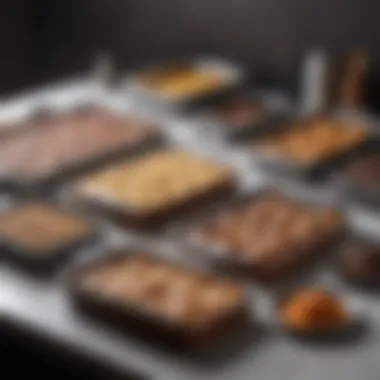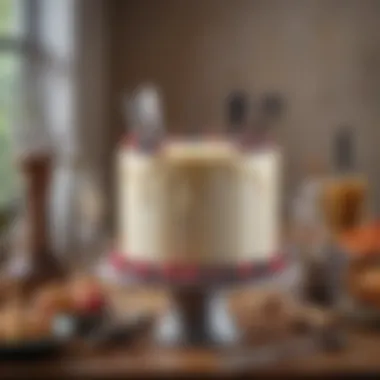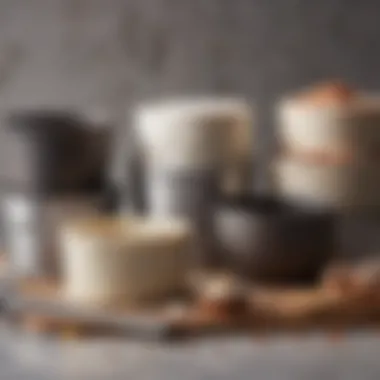Essential Cake Making Utensils: A Comprehensive Guide


Intro
Baking a cake is both an art and a science. The tools and utensils that one employs are crucial in achieving the desired texture and flavor. Understanding the purposes and features of each utensil can significantly enhance the baking experience.
In this article, we will explore the fundamental utensils involved in cake making. Each section will delve into the specific tools, illustrating how they contribute to crafting the perfect cake. We will also discuss the materials used in these tools, their maintenance, and tips for best use. Whether you are just starting out or you are looking to refine your technique, this guide is designed for you.
As we dissect these essentials, remember that every tool has its unique significance, aiding bakers in their pursuit of baking excellence.
Foreword to Cake Making Utensils
The journey of cake making cannot be achieved without the right tools. Understanding the importance of quality utensils can be the difference between a flawless cake and a disappointing one. The choice of tools influences not just the efficiency of the baking process but also the final outcome. In this article, we will explore the essential utensils that every baker should consider, revealing their functions and benefits. Knowing which tools are necessary simplifies the cake-making experience.
Importance of Quality Utensils
Quality utensils serve as the foundation for any baking endeavor. When it comes to baking, the precision of measurements and evenness of heat can significantly affect the results. For instance, investing in high-quality baking pans ensures even cooking and prevents common issues such as uneven rising or burning. Moreover, tools made from durable materials last longer and are often easier to clean and maintain.
Using inferior or cheap utensils can lead to frustration. A flimsy mixing bowl may tip over, or a non-stick pan may not perform as expected, resulting in ruined batter. Thus, understanding the significance of these tools enhances not just the baking process, but also the enjoyment of cake making itself.
Overview of Essential Tools
When setting out to create cakes, certain essential tools are indispensable. Here is a brief overview of some key utensils every baker should have:
- Baking pans: Different shapes and sizes allow for versatility in cake designs.
- Mixing bowls: Wide and deep to accommodate varied ingredients and labor.
- Measuring cups and spoons: To ensure precision in quantities, leading to consistent results.
- Whisks and spatulas: For thorough mixing and blending.
Each of these tools plays a vital role in creating a successful cake. Understanding their functions and how they contribute to the overall process can greatly improve a baker's ability to create stunning desserts.
Baking Pans and Their Varieties
Baking pans are crucial tools in cake making. They determine not only the shape and size of the cake but also affect the cooking time and even the texture. A well-chosen baking pan can make a significant difference in the final product. This section explores various types of baking pans and the materials they are made from, which together influence baking outcomes.
Types of Baking Pans
Round Cake Pans
Round cake pans are the most traditional type of baking pans used in cake making. They come in various sizes, often ranging from 6 to 12 inches in diameter. The key characteristic of round cake pans is their uniform depth and shape, which contributes to even baking. This type of pan is a popular choice for layered cakes, cheesecakes, and more.
A unique feature of round cake pans is that they allow for easy stacking of layers. However, one should consider that achieving a smooth dome may require meticulous leveling after baking, which can be seen as a disadvantage.
Square Cake Pans
Square cake pans are versatile and can be used for various baked goods, including brownies and coffee cakes. They usually come in sizes like 8x8 or 9x9 inches. The key characteristic of square pans is their corners, which can allow for sharper edges in the cake.
This makes them an excellent option for cakes that need to be cut into neat pieces, such as sheet cakes. However, one disadvantage is that they may not always offer the same aesthetic appeal as round cakes, which are often more visually pleasing for celebrations.
Bundt Pans
Bundt pans are a distinctive type of baking pan featuring intricate shapes. These pans are great for producing visually striking cakes with a beautiful design. The key characteristic of Bundt pans is their shape, which is designed to maximize surface area for a more even bake.
They are a beneficial choice for moist cakes like pound cake, as they tend to hold heat well. However, the unique design can make them difficult to clean and require careful greasing to avoid sticking.
Sheet Pans
Sheet pans, also known as jelly roll pans, are rectangular and ideal for baking large quantities. They generally come in sizes like 13x18 inches. The key characteristic of sheet pans is their shallow depth, allowing for a more surface area to volume ratio.
This makes them a good option for sheet cakes and bar cookies that require even baking. However, the main disadvantage is that cakes baked in sheet pans are less dramatic in shape compared to round or Bundt cakes.
Material Considerations
Different materials used in baking pans can greatly affect baking performance, heat distribution, and ease of cleaning.


Aluminum
Aluminum pans are lightweight and provide excellent heat conduction. This results in even baking, making them a popular choice among bakers. A unique feature of aluminum is its ability to cool down rapidly, which can help prevent overbaking. However, aluminum pans can react with acidic ingredients, so it is essential to consider this factor when choosing a pan.
Non-stick Coatings
Non-stick pans are favored for their ease of use. They allow cakes to release easily without sticking, which is a significant advantage for both novice and experienced bakers. However, non-stick coatings can sometimes wear off, leading to potential sticking issues over time.
Glass
Glass baking pans are known for their ability to allow bakers to see how the cake is browning. This transparency can prevent overcooking, as you can monitor the cake closely. However, glass pans are generally heavier and may distribute heat less evenly compared to metal pans.
Silicone
Silicone bakeware has gained popularity due to its flexibility and non-stick properties. These pans can withstand extreme temperatures and are easy to clean. While silicone pans can facilitate easy removal of cakes, they might not provide the same level of browning as metal pans, which can be seen as a disadvantage.
Choosing the right baking pan is essential. Not only does it affect the shape and texture of the cake, but it also influences the baking time and temperature.
Mixing Utensils: The Backbone of Cake Preparation
Mixing utensils play a crucial role in the cake-making process. They facilitate the thorough combination of ingredients, which is essential for achieving the desired texture and flavor in cakes. The proper mixing tools ensure that the batter is consistent and well-integrated, leading to better baking results. Employing the right mixing utensils not only improves efficiency but also enhances the overall quality of the cake.
Types of Mixing Bowls
Glass Mixing Bowls
Glass mixing bowls are widely favored for their transparency and sturdiness. They are non-reactive, which means they do not interact with acidic ingredients like vinegar or lemon juice, making them a safe choice for all types of cake batter. One of the key characteristics of glass bowls is their ability to withstand microwave and oven temperatures, allowing bakers to use them for melting butter or chocolate.
Advantages of glass mixing bowls include their durability and ease of cleaning. However, they can be heavy and may break if dropped.
Plastic Mixing Bowls
Plastic mixing bowls are popular due to their lightweight and varied sizes. They are also less prone to breakage compared to glass bowls. However, not all plastic bowls are created equal; some can absorb odors and stains over time. Their flexibility is beneficial, especially when using a hand mixer. One key characteristic is their practicality for batter mixing and ingredient storage.
While plastic bowls are affordable and versatile, they can warp or scratch with frequent use.
Stainless Steel Mixing Bowls
Stainless steel mixing bowls stand out for their strength and resistance to rust and corrosion. They can handle a wide range of temperatures, which makes them an ideal choice for both hot and cold mixtures. The shiny surface is easy to clean and is often dishwasher safe. One unique feature of stainless steel bowls is their ability to maintain cold temperatures, helping to stabilize mixtures that require precise temperatures.
Though they are durable, they can be more expensive than plastic or glass bowls. Some note that they can be heavy when filled.
Essential Mixing Tools
Whisks
Whisks are essential for incorporating air into cake batters, especially for light and fluffy textures. The key characteristic of whisks is their ability to mix ingredients quickly, making them a favorite among bakers. Whisks made from stainless steel or silicone are especially popular.
The primary advantage of using a whisk is their effectiveness A downside is that they require more effort than electric mixers for larger batches.
Spatulas
Spatulas are crucial for scraping down the sides of mixing bowls to ensure that all ingredients are blended effectively. The key characteristic of a good spatula is its flexibility, allowing for easy maneuvering in tight spaces. Silicone spatulas have gained popularity because they can withstand heat and are gentle on non-stick cookware.
Spatulas are versatile and easy to use. Yet, low-quality spatulas can become warped over time.
Electric Mixers
Electric mixers drastically reduce the time and effort needed for mixing cake batter. They come in many forms, including stand mixers and hand mixers. An essential aspect of electric mixers is their speed and power, enabling them to handle thick batters with ease.
Although they save time, electric mixers can be more expensive and require careful maintenance.


Rubber Scrapers
Rubber scrapers are used for a variety of tasks, including folding ingredients and scraping batter from bowls. Their flexibility allows the scraper to conform to the shape of the bowl, making it an efficient tool for ensuring nothing is wasted. A key characteristic of rubber scrapers is their heat resistance, which makes them suitable for multiple uses in cake making.
While rubber scrapers are versatile and easy to clean, they may not be as durable against sharp knives and tools.
Measuring Tools for Accurate Baking
Measuring tools are critical in cake making. They ensure that the right amounts of ingredients are used. Accurate measurements prevent baking disasters and poor outcomes. Scalability of recipes also relies on precise measurements, allowing for consistency across batches.
Dry Measuring Cups vs. Liquid Measuring Cups
There are notable differences between dry measuring cups and liquid measuring cups. Dry measuring cups are designed to hold dry ingredients like flour and sugar. They typically come in a set of various sizes. Lightly spooning the ingredient into the cup and leveling it off with a flat edge is essential for accuracy.
Liquid measuring cups, however, have a spout and are marked with measurements along the side. They are used for liquids such as water, milk, and oil. When measuring liquids, it is important to ensure the cup is on a flat surface. The eye should be level with the measurement marking. This ensures you are not misled by the meniscus, the curve formed by liquid.
"Accurate measurement is a baker's best friend. It makes or breaks a recipe."
Measuring Spoons: A Closer Look
Measuring spoons are crucial for small volumes of ingredients. They typically come in sets, ranging from 1 tablespoon to 1/4 teaspoon. Using spoons ensures precision, especially for potent ingredients like baking powder, salt, or spices. Just like measuring cups, they should be used with care. Ingredients should be scooped and leveled off for accuracy.
It is worth noting that using a tablespoon instead of a teaspoon can lead to significant errors in recipes. Always refer to the various measures needed in your specific cake recipe and make sure to use the correct spoon.
Importance of Kitchen Scales
Kitchen scales offer the highest level of measurement accuracy in baking. They allow for weighing ingredients instead of measuring by volume. Ingredients can have varying densities, affecting the volume measurement. For example, a cup of flour can weigh different amounts depending on how it’s packed.
Using a kitchen scale helps mitigate these issues. Digital scales provide a precise reading. They also often have tare functions, which allow you to weigh ingredients in a bowl without accounting for the bowl's weight.
Ovens and Their Role in Baking
Ovens are integral to the cake-making process. They provide the controlled heat necessary for baking. Different types of ovens have unique features that affect how cakes rise and develop textures. Selecting the right oven can significantly influence the outcome of your baking. In this section, we will explore key aspects of ovens, specifically conventional and convection types, as well as focusing on safety and maintenance to ensure optimal performance.
Understanding Oven Types
Conventional Ovens
Conventional ovens are the most common type found in home kitchens. They operate by heating air inside the oven cavity, relying on one or more heating elements, often located at the top and bottom. The key characteristic of conventional ovens is their simple operational mechanism, making them easy to use and accessible for all bakers. They provide steady and consistent heat, which helps cakes bake evenly.
One unique feature of conventional ovens is the use of radiant heat. This heat source can sometimes lead to uneven baking, especially for larger cakes or when multiple trays are in use. Despite this, their popularity remains strong because they typically excel at creating moist and tender cakes, making them a reliable choice for a variety of baking recipes.
Convection Ovens
Convection ovens differ in design. These ovens are equipped with a fan and exhaust system that circulates hot air around the food. This specific aspect significantly enhances heat distribution. The primary advantage of convection ovens is their ability to bake more uniformly. They work faster than conventional ovens, reducing baking time by about 25%.
The key characteristic that makes convection ovens a beneficial option is the fan that promotes even airflow. As a result, cakes tend to rise evenly and develop a uniform crust. However, users must take care to adjust baking times and temperatures due to the increased efficiency of these ovens. Sometimes too much circulation can dry out delicate cakes, which is a disadvantage to consider when baking.
Oven Safety and Maintenance
Ensuring safety and maintaining your oven is essential for optimal functionality. Regular cleaning prevents the buildup of grease and food residues, which can affect performance and may even trigger unwanted odors.
- Best Practices for Cleaning
- Safety Tips
- Use non-abrasive cleaners to avoid scratching surfaces
- Wipe spills after they occur to make deep cleaning easier
- Periodically check for any signs of damage or wear on seals
- Always preheat your oven to ensure consistent baking temperatures
- Avoid overcrowding the oven; leave enough space for air circulation
Regular maintenance not only extends the life of the oven but also ensures safe and efficient baking.
Decoration Tools and Techniques


Decoration tools and techniques play a crucial role in the art of cake making. They transform a simple baked good into a visual masterpiece. Whether for celebrations or personal enjoyment, the decorations not only enhance the cake's appearance but also elevate the dining experience. Understanding these tools helps bakers achieve the desired aesthetics and textures on their creations. Furthermore, mastering decoration techniques can lead to the development of one's unique style in cake making.
Essential Decorating Utensils
Offset Spatulas
Offset spatulas are essential for the smooth application of frostings and spreads on cakes. Their characteristic shape, which includes a slight bend in the blade, allows for an even distribution of icing without disturbing the cake underneath. This design makes them a popular choice among bakers.
The unique feature of offset spatulas is their versatility. They can be used for both frosting and lifting delicate layers of cake. One of the advantages is their ability to reach into tight spaces, such as between cake layers. However, they are not ideal for heavy duty tasks or for spreading thick mixtures.
Decorating Bags
Decorating bags, also known as piping bags, are critical for detailed cake design. They allow for precise control when applying frosting, enabling bakers to create intricate designs. The key characteristic of decorating bags is their flexibility. Made from various materials, such as plastic or fabric, they accommodate different decorating tips.
A unique feature of these bags is that they can be used with multiple tips, allowing for various icing patterns and textures. The advantage is significant as it expands design possibilities. On the downside, they require some practice to master, and if not properly handled, can create messes.
Tips and Nozzles
Tips and nozzles are integral to effective cake decoration. Each tip has a unique shape that produces distinct designs, from simple dots to detailed flowers. The key characteristic of tips and nozzles is their ability to create a variety of effects, enhancing creativity in decorating.
Their unique feature lies in the range available, from star tips to round tips, each serving different purposes. Advantages include the ease of use for both novice and experienced bakers. However, maintenance can be challenging as they need to be cleaned thoroughly after use to avoid clogs.
Using Fondant and Tools
Fondant is a popular medium for cake decoration, providing a smooth finish and flexibility. There are various tools specifically designed for handling fondant, like rolling pins, smoothers, and cutters. Utilizing these tools is key to achieving a polished and professional look.
Fondant can be tricky to work with, as it dries quickly and can crack. It’s important to practice the techniques for rolling, cutting, and applying fondant. Overall, the right utensils and understanding of techniques enhance the final results, bringing creativity and beauty to cake making.
Maintenance of Cake Making Utensils
Maintaining your cake making utensils is key to achieving the best baking results. Proper care ensures that each tool performs optimally and lasts longer, saving you money in the long run. This section delves into the cleaning practices and storage methods that guarantee your utensils are always ready for the next baking venture.
Cleaning Best Practices
Cleaning your utensils is not just about aesthetics; it significantly impacts food safety and performance. Here are some recommended practices:
- Immediate Cleaning: Wash utensils soon after use. This prevents batter or frosting from hardening and becoming difficult to remove.
- Use Warm Soapy Water: Most utensils will benefit from a gentle wash in warm soapy water. Avoid harsh abrasives that can scratch surfaces.
- Dishwasher Safety: Check if your utensils are dishwasher safe. Some materials, like silicone, often tolerate this, while others may warp or get damaged.
- Storage for Longevity: When storing your utensils, make sure they are dry to prevent mold or odor. Some may require special care, such as wooden tools, which might need oiling to prevent drying and cracking.
"Proper maintenance of cake making tools prolongs their life and enhances your baking experience."
Storing Your Utensils
The way you store your cake making utensils directly influences their lifespan. Here are pointers for effective storage:
- Organized Spaces: Arrange utensils in a designated area. Use drawers or tool organizers to avoid tangling or wear and tear.
- Separate Heavier Items: Keep heavy mixing bowls away from fragile items like glass measuring cups to minimize the chance of breakage.
- Avoid Overcrowding: When stacking items, do so carefully. Crowded spaces can lead to scratched surfaces or damaged tools.
- Climate Considerations: Store your utensils in a dry area to prevent rust, especially for metal tools. Avoid humid places where moisture can affect their quality.
Through consistent cleaning and proper storage methods, your cake making utensils will serve you well for many baking projects. This practice not only maintains quality but also enhances your overall baking experience.
Ending
The conclusion serves as an integral part of this article, tying together all aspects of essential cake making utensils. It reinforces the significance of understanding the variety of tools available and how they contribute to successful baking. By emphasizing the role each utensil plays, readers can appreciate the art and science of cake making.
When you are equipped with the right tools, you enhance your ability to create impressive cakes. Quality utensils ensure consistency in your results, from the perfect rise of a cake to the artistry in decorating. As such, investing in quality tools cannot be overstated. It affects every stage of the cake-making process, including preparation, baking, and decorating.
Building Your Cake Making Arsenal
To build your cake making arsenal effectively, consider focusing on several key elements. First, choose a selection of high-quality baking pans. It is important to select different shapes like round, square, and bundt pans. Each serves a distinct purpose and allows for a variety of cake styles. Next, invest in sturdy mixing bowls and essential mixing tools. A combination of whisks, spatulas, and an electric mixer will cover most cake recipes.
Moreover, measurement accuracy is paramount. Use both dry and liquid measuring cups, along with a good set of measuring spoons. A kitchen scale is also a wise purchase, particularly for more precise baking tasks.
In terms of decoration, don’t overlook the importance of decorating tools. Items like offset spatulas, decorating bags, and various nozzles will enhance your ability to create beautiful finishes on your cakes.
Finally, maintain your utensils properly. Regular cleaning and careful storage will prolong their life and maintain their effectiveness. By following these considerations, you build an effective cake making arsenal that makes the baking process enjoyable and successful.
"The right tools can make the difference between average and exceptional baking."
In summary, understanding and selecting the right utensils is a pivotal first step in your cake-making journey, setting the foundation for both technique and creativity in your baking endeavors.



